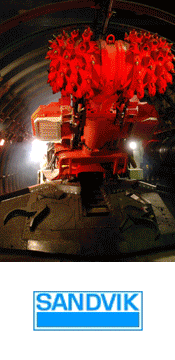Hong Kong closing out West Drainage scheme
Sep 2011
Peter Kenyon, TunnelTalk
- Work on the HK$3 billion (US$383 million) Hong Kong West Drainage Tunnel is in its final phases with Australian contractor Macmahon reporting that it has completed 17 of the 23 raise bore dropshafts which will complete the complex tunnelling system. Project Manager Hayden Clarke told TunnelTalk that two more shafts will be completed by the end of this week, with Macmahon on course for a mid December finish.
- Clarke reported that the scheme illustrates the operational and environmental benefits of raised boring in built up and difficult-to-access urban areas.
- "This is one of the most logistically challenging jobs we have worked on," said Clarke. "The majority of the raise bore sites are in highly urbanised areas with restrictions on noise, traffic and dust emissions, and sites that are extremely tight.
- "Not only is there very little room to manoeuvre and operate the equipment, in many cases the sites are on very steep terrain with little normal road access. The benefits of raise boring keep disturbance to the public minimal.
-

Macmahon Project Manager Hayden Clarke
- "There is virtually no dust, and the spoil is carried out through the tunnel. The rigs are quiet and the sound of boring is contained underground."
- Macmahon is using four drill rigs - three Atlas Copco and one Sandvik Rhino unit - to raise the 23 shafts. This allows excavation of up to four dropshafts at a time during this 18-month phase of the project. The shafts range between 44m and 172m deep and are being reamed to either 2.44m or 3.15m diameter. Each raise begins with a 35cm pilot hole drilled using Sandvik Pilot bits and 28.6cm drill pipes. Four Sandvik CRH8E extendable reamers, consisting of a base-head to which four segments can be bolted to different diameters, raise the shafts to one of the two fixed diameters.
- The shaft bores completed to date have encountered varying degrees of ground quality and stability, including hard granites and volcanic tuff some of which have compressive strengths of more than 250 MPa. "There is some exceptionally hard ground here, but overall we are achieving very good penetration rates," said Clarke.
- The Sandvik reaming heads can be adapted to different rock conditions by re-arranging the cutters.
- In total the project consists of 32 dropshafts (some of them have ground conditions unsuitable for raiseboring), 32 adits, 34 intakes and two tunnel portals.
-

Fig 1. Route of the project's main drain, adits and dropshafts
- Designed by consulting engineer Ove Arup & Partners, the Hong Kong West Drainage Scheme is being carried out by the Dragagnes-Nishimatsu JV. Work on the project began in November 2007 and is on schedule for completion in 2012. The main 10.5km drainage tunnel, linking Tai Heng with the sea at Cyberport, was completed in two TBM drives of 6.25m and 7.25m diameter. The TBMs (both Herrenknecht rock machines) met for a mid tunnel junction under the Aberdeen highway tunnel on 17 February this year (2011) (Fig 1).
- Drill+blast was used to excavate a series of 2.3-3.5m-wide adits to connect the main tunnel with the dropshafts that accept runoff from 34 intake points. These intake points intercept rainwater from open channels and underground drainage pipes (Fig 1 and 2). The water discharges via the main tunnel by gravity to the sea at Cyberport.
-

Fig 4. Giant storage tanks will facilitiate discharge
-
Serious flooding
The project, when completed, will prevent the serious flooding that has occurred in downtown Hong Kong in recent years. In addition to having one of the highest annual rainfalls of all the Pacific Rim cities (2.2m per year average), the aging current drainage system is seriously undercapacity for servicing the needs of one of the most densely populated areas of Hong Kong. - Storm water control is also under high pressure due to Hong Kong's topography as rain runs off the steep gradients, and from below when high tides prevent effective discharge due to back-flow (Fig 2 and 3).
- Part of the project has involved excavation of storm drainage tanks close to the discharge point to store excess floodwater also when high tides prevent the outflow (Fig 4).
-
Planning of deep sewage tunnels in Hong Kong - TunnelTalk, May 2009
Hong Kong confirms HATS contract award - TunnelTalk, Aug 2009
|
|
|
|
|
Add your comment
- Thank you for taking the time to share your thoughts and comments. You share in the wider tunnelling community, so please keep your comments smart and civil. Don't attack other readers personally, and keep your language professional.













